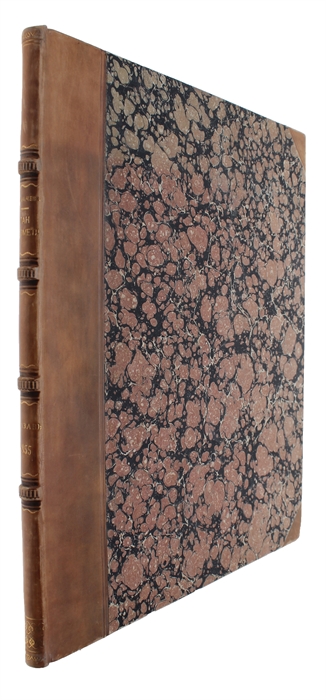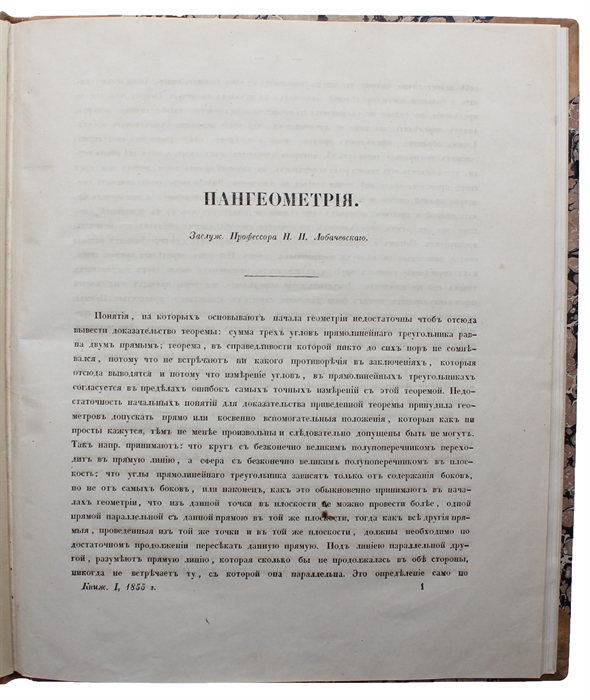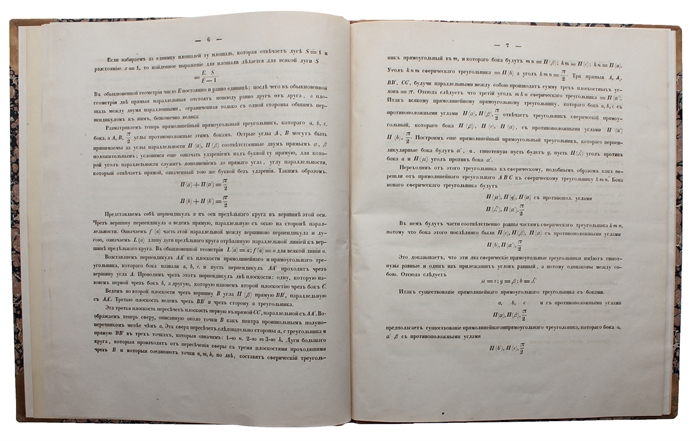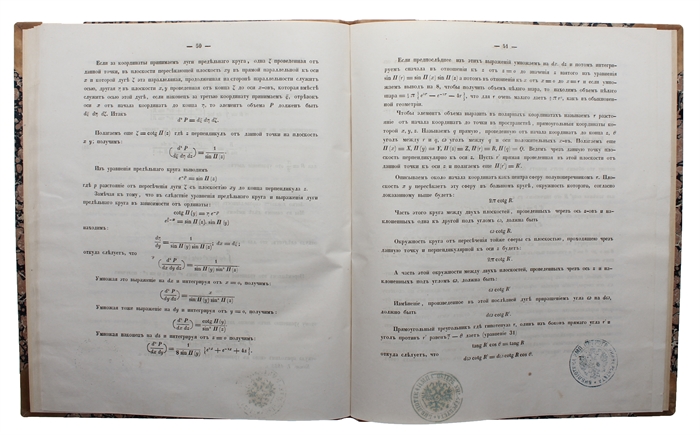"THE MOST CONSEQUENTIAL AND REVOLUTIONARY STEP IN MATHEMATICS SINCE GREEK TIMES"
LOBACHEVSKY (LOBACHEVSKII, LOBACEVSKIJ, LOBATSCHEWSKIJ), (NIKOLAI IVANOVITSCH).
Pangeometriya (i.e. Pangeometry). (In: "Uchenye zapiski").
Kazan, Kazan University Press, 1855-56.
4to (263 x 216 mm). In a nice later half calf binding with four raised bands and marbled paper covered boards. Extracted from "Uchenye zapiski, Imperatorskago Kazanskago Universiteta", 1855, vol. 1. Two library-stamps to p. 51 with offsetting to p. 50 and small stamp to last free end-paper. With very light creasing to outer margin, otherwise a fine and clean copy. 56 pp.
Exceedingly rare first appearance of Lobachevsky’s landmark 'Pangeometry', a seminal work that serves as a synthesis of his exploration into non-Euclidean geometry and its practical applications and is widely considered his clearest account of the subject. It is also the conclusion of his life's work and the last and final attempt he made to acquire recognition. Lobachevsky's contributions not only marked a turning point in mathematical thought, but were also a catalyst for profound shifts in physics, and philosophy as they expanded the boundaries of human understanding, challenging 2000 year old conventional wisdom; consequently, he is often referred to as "The Copernicus of Geometry". Lobachevsky wrote his Pangeometry in 1855, the year before his death, at a time when he was completely blind. He dictated two versions, a first one in Russian (the present), and a second in French. Despite his revolutionary work, Lobachevsky’s received little, if any, attention from the scientific community. One reason for this was that his works were published in very small numbers in relatively obscure journals – they seem to have had minimal circulation even within Russia. The present treatise contains basic ideas of hyperbolic geometry, including the trigonometric formulae, the techniques of computation of arc length, of area and of volume, with concrete examples. It also deals with the applications of hyperbolic geometry to the computation of new definite integrals. “Lobachevskii’s geometry represents the culmination of two thousand years of criticism of Euclid’s fifth, or parallel, postulate, which states that given a line and a point not on the line, there can be drawn through the point one and only one coplanar line not intersecting the given line. As this postulate had stubbornly resisted all attempts (including Lobachevskii’s) to prove it as a theorem, Lobachevskii came to the realization that it was possible to construct a logically consistent geometry in which the Euclidean postulate represented a special case of a more general system that allowed for the possibility of hyperbolically curved space. Lobachevskii’s system refuted the unique applicability of Euclidean geometry to the real world, and pointed the way to the Einsteinian concept of variably curved space” (Norman 1379.). “At the same time as Lobachevsky, other geometers were making similar discoveries. Gauss had arrived at an idea of non-Euclidean geometry in the last years of the eighteenth century and had for several decades continued to study the problems that such an idea presented. He never published his results, however, and these became known only after his death and the publication of his correspondence. Janos Bolyai, the son of Gauss’s university comrade Farkas Bolyai, hit upon Lobachevskian geometry at a slightly later date than Lobachevsky. Since Gauss did not publish his work on the subject, and since Bolyai published only at a later date, Lobachevsky clearly holds priority.” DSB. Lobachevsky's non-Euclidean geometry paved the way for further advancements in mathematics, including the development of differential geometry and the study of Riemannian manifolds. These areas of mathematics have found applications in fields as diverse as physics, engineering, and computer science.
Furthermore, his work laid the groundwork for Albert Einstein's theory of general relativity, which relies on the concept of curved spacetime. It showed that there is no single "correct" geometry, but rather multiple valid systems. This led to a broader understanding of the nature of axiomatic systems and their relation to reality - implications that extend well beyond the realm of mathematics, shaping our understanding of space, reality, and the limits of human knowledge.
Order-nr.: 60473




